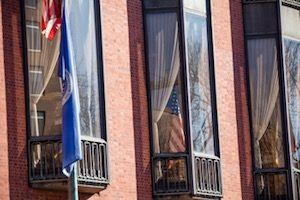 Rembrandt Wireless Techs., LP v. Samsung Elecs. Co., (Fed. Cir. Apr. 17, 2017) (Before Taranto, Chen, and Stoll, J.) (Opinion for the court, Stoll, J.).
Rembrandt Wireless Techs., LP v. Samsung Elecs. Co., (Fed. Cir. Apr. 17, 2017) (Before Taranto, Chen, and Stoll, J.) (Opinion for the court, Stoll, J.).
Rembrandt sued Samsung for patent infringement in the Eastern District of Texas and convinced a jury that Samsung infringed its two asserted patents, awarding $15.7 million in damages. Samsung appealed claim construction, denial of JMOL of obviousness, a Daubert motion on a damages expert, and the refusal to limit damages.
The Federal Circuit upheld the district court’s claim construction because the lower court had correctly used the prosecution history to interpret the claim. That is, the “clearest statement in the intrinsic record regarding the meaning of the ‘different types’ limitation is the descriptive statement [in the prosecution history].” Samsung’s reliance on the plain language of the claim and the specification were insufficient to supplant the “unambiguous statement in the prosecution history.”
The Court also upheld the denial of JMOL for obviousness, finding that substantial evidence supported both of the jury’s presumed findings: that the prior art reference did not teach a limitation; and that there was no motivation to combine. First, the jury was free to credit Rembrandt’s expert over Samsung’s in finding the prior art did not teach the limitation. Second, combining the prior references would have required a POSA to make a lateral or possibly detrimental change in the primary reference. This illogical substitution was sufficient to support the jury’s finding of no motivation to combine.
The Court also found no reversible error in the testimony of Rembrandt’s expert on damages. As such, the jury’s award was supported by substantial evidence.
Finally, the Court reviewed the district court’s decision to allow Rembrandt to recover pre-notice damages, even though it had failed to comply with the marking statute. Rembrandt had licensed one of its asserted patents and the licensee had failed to mark a product embodying an asserted claim. After Samsung sought to limit Rembrandt’s damages based on the marking statute, Rembrandt withdrew its assertion of the claim embodied in the licensee’s product and filed a statutory disclaimer of that claim with the USPTO. The district court ruled that the disclaimer required it to treat the claim as “if it never existed.” The Federal Circuit vacated because allowing Rembrandt to “avoid the consequence of its failure to mark undermines the marking statute’s public notice function.” The Federal Circuit remanded to the district court to properly limit damages, and also remanded the question of whether the marking statute applies on a patent-by-patent or claim-by-claim basis because the parties had not squarely addressed the issue during the present appeal.
Clarifying a claim term during prosecution may supersede ordinary meaning and the definition in the specification. Surrendering a patent claim by disclaimer, after the fact, will not remedy a failure to mark products with a patent notice, and will not revive pre-notice damages. Further litigation may address whether waiver of damages for failure to mark requires a claim-by-claim analysis (versus a patent-by-patent analysis).
[Troutman-Ad]
[Troutman-About]

![[IPWatchdog Logo]](https://ipwatchdog.com/wp-content/themes/IPWatchdog%20-%202023/assets/images/temp/logo-small@2x.png)


![[Advertisement]](https://ipwatchdog.com/wp-content/uploads/2024/04/UnitedLex-May-2-2024-sidebar-700x500-1.jpg)
![[Advertisement]](https://ipwatchdog.com/wp-content/uploads/2024/04/Artificial-Intelligence-2024-REPLAY-sidebar-700x500-corrected.jpg)
![[Advertisement]](https://ipwatchdog.com/wp-content/uploads/2024/04/Patent-Litigation-Masters-2024-sidebar-700x500-1.jpg)

![[Advertisement]](https://ipwatchdog.com/wp-content/uploads/2021/12/WEBINAR-336-x-280-px.png)
![[Advertisement]](https://ipwatchdog.com/wp-content/uploads/2021/12/2021-Patent-Practice-on-Demand-recorded-Feb-2021-336-x-280.jpg)
![[Advertisement]](https://ipwatchdog.com/wp-content/uploads/2021/12/Ad-4-The-Invent-Patent-System™.png)






Join the Discussion
3 comments so far.
angry dude
April 23, 2017 08:16 pmBut…there is a robust patent market in US nevertheless … according to some…
:):):)
Gene Quinn
April 23, 2017 08:04 pmPaul @1
Not sure how you could come to that conclusion. Obviously, Samsung prevailed. They were able to infringe and damages are going to be significantly reduced. Not sure how anyone could characterize that as anything other than a victory for Samsung. Given the marking question they may get out of this paying little or nothing.
Paul
April 23, 2017 01:26 pmLabeling a remand to properly limit damages as a ‘success’ after being found guilty of patent infringement, upheld on appeal, is like claiming victory for being disqualified from a rematch.